Delving into the nocturnal realm of owls unveils a world of wonder where the Spotted Owlet stands out as a captivating figure. Native to Asia, this diminutive bird boasts a striking appearance with its speckled plumage and piercing yellow eyes.
What truly intrigues is its adaptability, flourishing across diverse landscapes from dense forests to bustling urban centers. As an omnivore, its diet spans from insects to small mammals and reptiles, showcasing its resourcefulness in varying habitats.
In the following exploration, we’ll delve into the intricate life cycle of the Spotted Owlet, unveiling its breeding habits and lifespan.
Whether you’re a seasoned birder or drawn to the mysteries of wildlife, there’s a magnetic allure in unraveling the secrets of these enchanting creatures.
Habitat of the Spotted Owlet
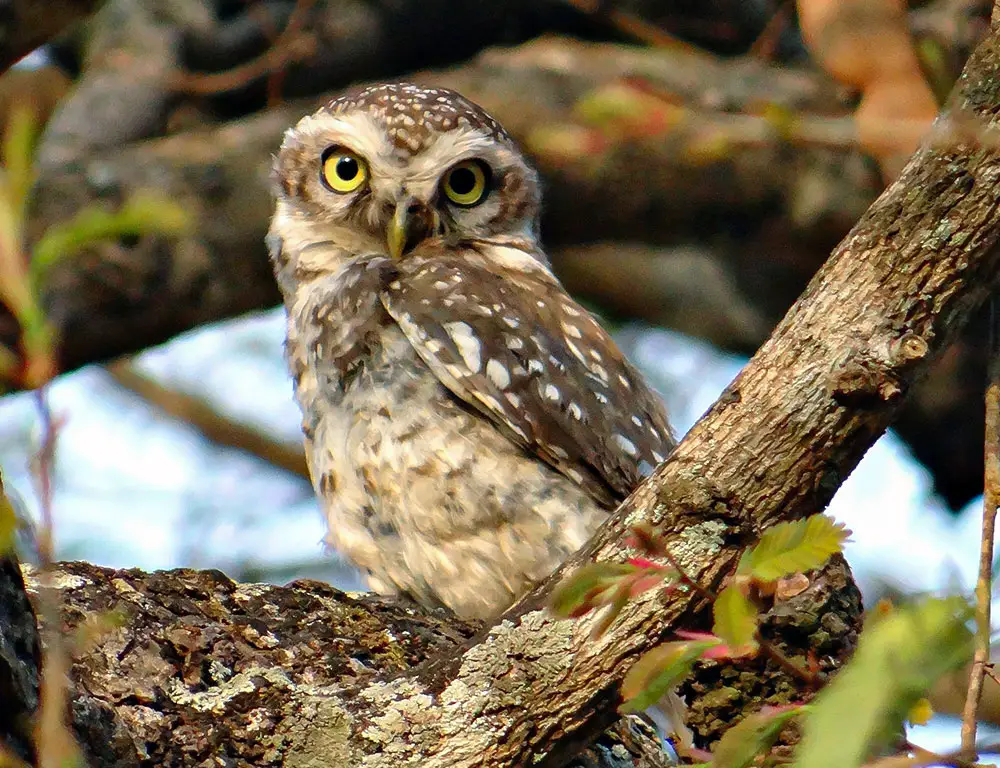
The Spotted Owlet (Athene brama) is known for its remarkable adaptability to diverse habitats, ranging from woodlands and farmlands to semi-desert regions and rocky areas.
Here’s a breakdown of its habitat preferences:
Semi-Desert Regions
Spotted Owlets have shown a remarkable ability to adapt to arid climates. Despite the harsh environment, they thrive by primarily feeding on insects, often abundant in such regions.
Rocky Areas
Spotted Owlets utilize rock crevices in rocky terrains as nesting sites, offering them natural camouflage against potential predators. These areas provide them with suitable shelter and nesting spots.
Human Settlements
Spotted Owlets are known for their tolerance of human presence. They readily inhabit human settlements, including old buildings, gardens, and urban areas. This adaptability to coexist with humans makes them a common sight in many populated areas.
Physical Characteristics of the Spotted Owlet
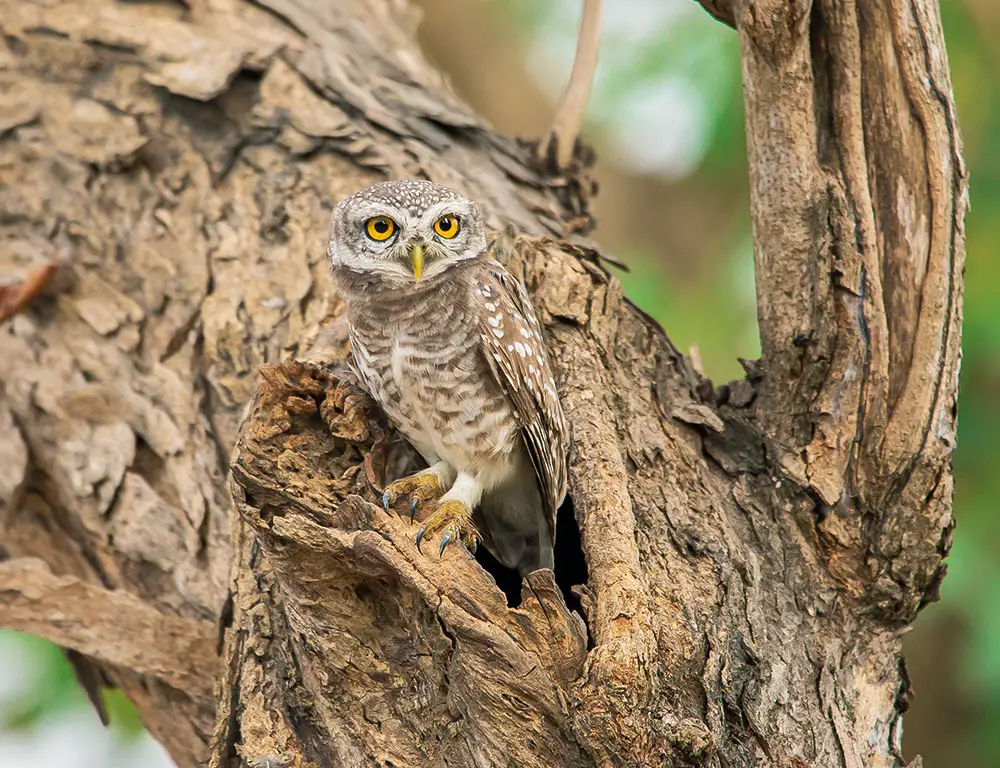
The Spotted Owlet (Athene brama) possesses distinctive physical characteristics, making it a fascinating subject for observation.
Here’s a breakdown of its notable features:
Size
The Spotted Owlet is relatively small, typically measuring around 21 cm in height, which is roughly equivalent to the size of an average water bottle.
Head and Upper Body
One of its most striking features is its white-spotted head and upper body, giving it a unique and easily recognizable appearance.
Eyes
The Spotted Owlet has large yellow eyes that contrast against its grey-brown face. These prominent eyes are essential for its nocturnal hunting habits.
“False Eyes”
Interestingly, the Spotted Owlet has “false eyes” on the back of its head, which are spots that mimic eyes. This adaptation serves to confuse potential predators.
Legs and Talons
It possesses stout legs that are feathered down to its sharp talons, a characteristic not found in all owl species. These nails are essential for capturing and holding prey.
Wings
The wings of the Spotted Owlet have a span that can reach up to 54 cm. They are marked by striking patterns of white bars and spots, aiding in flight and potentially in camouflage.
Plumage
The plumage of the Spotted Owlet displays a combination of colors, including grey-brown and white on the top side and paler hues underneath. This coloration provides effective camouflage among tree barks during daylight hours.
Diet and Feeding Habits of the Spotted Owlet
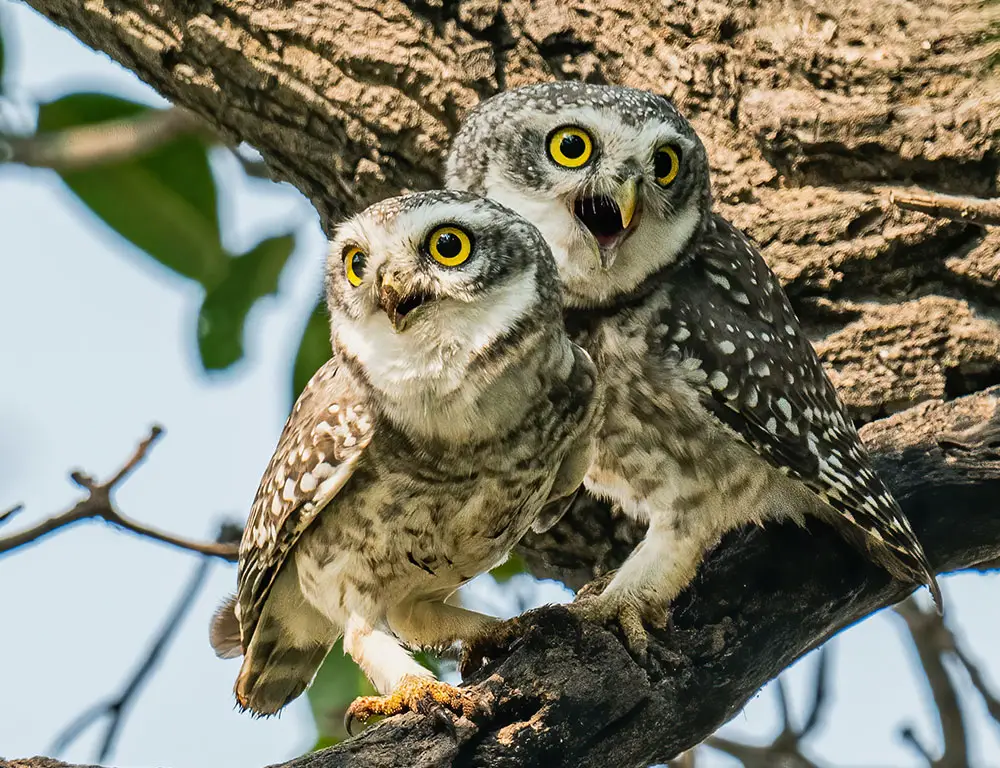
The diet and feeding habits of Spotted Owlets (Athene brama) showcase their adaptability and predatory prowess.
Here’s a detailed look at their dietary preferences and feeding behaviors:
Diet Composition
- Insects: Spotted Owlets primarily feed on insects, with beetles and moths being significant components of their diet. These insects make up approximately 70% of their overall diet.
- Small Mammals: While insects form the bulk of their diet, Spotted Owlets also consume small mammals such as mice and bats, constituting around 20% of their diet.
- Others: Other food items like crickets, earthworms, and scorpions contribute to the remaining 10% of their diet.
Feeding Habits
- Hunting Times: Spotted Owlets exhibit flexible hunting times, active at night and early morning hours. This behavior sets them apart from many strictly nocturnal owl species.
- Food Storage: An exciting behavior observed in Spotted Owlets is their tendency to store food. They capture prey and hide it in tree holes or crevices, creating a “pantry” for later consumption. This habit ensures a steady food supply even during times of scarcity.
- Feeding Style: Like many raptors, Spotted Owlets practice “mantling” while feeding. This involves hiding their catch under their wings to prevent theft by other predators. It’s a fascinating behavior highlighting their strategic approach to securing food.
Reproduction and Nesting Behavior of the Spotted Owlet
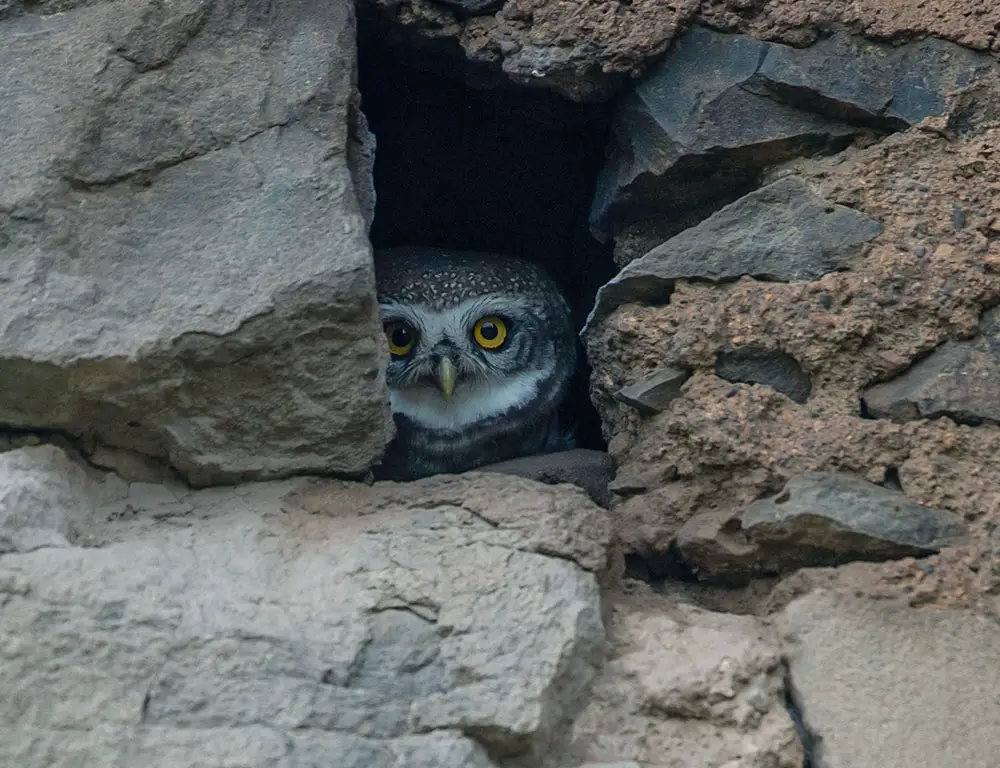
The reproduction and nesting behavior of Spotted Owlets (Athene brama) offer intriguing insights into their lifecycle and parental care strategies. Here’s a detailed overview:
Breeding Season
Spotted Owlets typically breed from February to May, with slight variations depending on their location.
Nest Preference
These owlets prefer to nest in cavities in trees or man-made structures such as abandoned buildings. They often reuse old woodpecker holes or other bird nests for breeding.
Number of Eggs
A female Spotted Owlet lays a clutch of typically two to four eggs at intervals of one to two days.
Incubation Period
The incubation period for Spotted Owlet eggs lasts approximately 30 days, during which the female is primarily responsible for incubating the eggs while the male provides food for her.
Nesting Behavior
Unlike many other bird species, Spotted Owlets do not construct elaborate nests. Instead, they lay their eggs directly onto the bare surface of their chosen cavity without any additional padding or structure.
Parental Care
After hatching, the owlet chicks depend entirely on their parents for food and protection. Both parents contribute to feeding the chicks, with the male bringing food to the nest while the female continues to brood and care for the young.
Development and Fledging
The owlet chicks remain in the nest for approximately six weeks, during which time they gradually develop and grow stronger.
They fledge and become capable of flight at around six weeks old, after which they begin to explore their surroundings and gradually become more independent.
Conservation Status of the Spotted Owlet
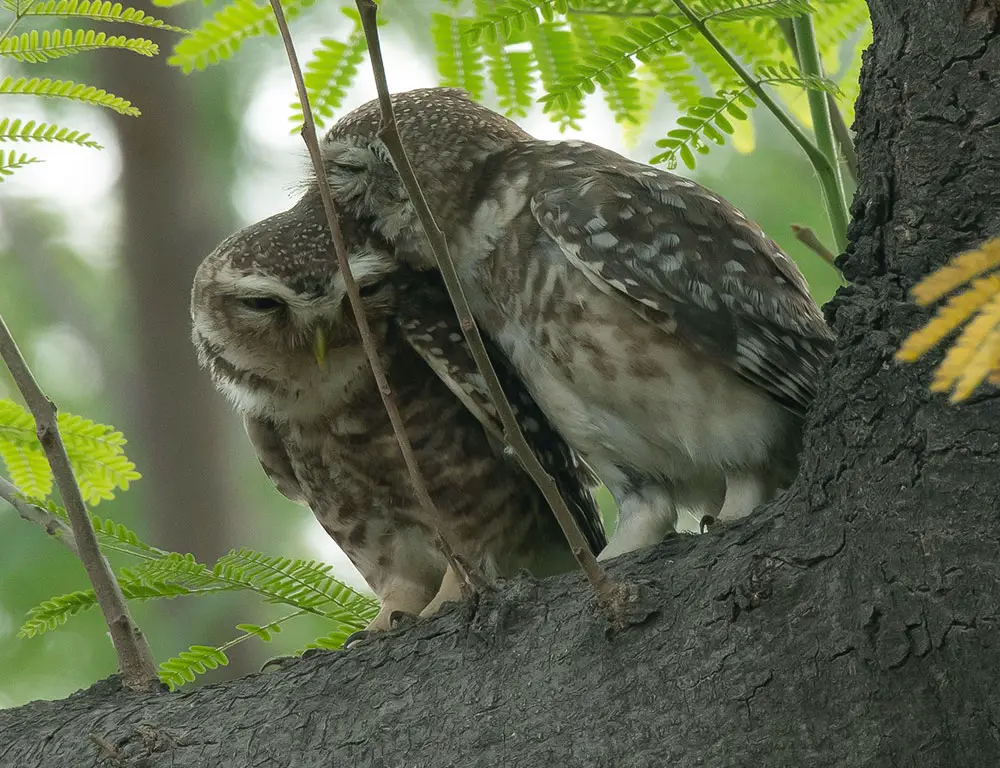
The conservation status of the Spotted Owlet (Athene brama) is classified as “Least Concern” by the International Union for Conservation of Nature (IUCN).
However, this designation doesn’t imply immunity from threats; instead, it highlights the need for continued monitoring and conservation efforts.
Here’s a deeper look at the conservation status and efforts aimed at safeguarding the Spotted Owlet:
Population Trends
While the spotted owl population was once estimated to be more than 10,000 individuals, recent data suggest a declining trend since 2020. Despite being stable in 2012, the population has shown signs of decline, indicating potential threats to survival.
Threats
Rapid urbanization and deforestation threaten spotted Owls by causing habitat loss and fragmentation. This forces them into human-dominated landscapes, where they may face increased resource competition and higher predation risks.
Conservation Efforts
- Community Awareness Programs: Initiatives to raise awareness among local communities about the importance of Spotted Owlets and the need for their protection are underway. These programs educate people about the significance of conserving their habitats and promoting coexistence.
- Habitat Preservation: Efforts to preserve natural habitats, including promoting sustainable farming practices, restricting deforestation, and establishing protected areas, play a crucial role in conserving Spotted Owlet populations. Creating safe havens where wildlife can thrive without human interference is essential for long-term survival.
Individual Action
Encouraging individuals to take action in their capacity, whether through supporting conservation organizations, participating in citizen science projects, or advocating for environmental protection, can contribute to conserving Spotted Owlets and their habitats.
Conclusion
The spotted Owlet emerges as a remarkable species, demonstrating adaptability and intelligence in its diverse habitats.
Beyond its role as a nocturnal predator, this bird is vital to ecosystem balance, particularly in controlling rodent populations.
Its ability to thrive in varied environments, from urban landscapes to dense forests, underscores its resilience and importance in maintaining biodiversity.
Understanding and appreciating creatures like the Spotted Owlet deepen our connection to the natural world and recognize our responsibility to conserve and protect it.
Preserving these species is not merely an option but a necessity for the health of our planet’s ecosystems.
Let us continue to cherish and safeguard our feathered companions, recognizing their integral role in nature’s intricate web of life.